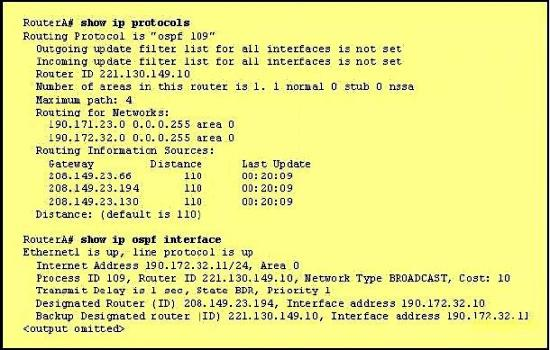Refer to the exhibit:

Why was RouterA not elected as the designated router?

A.
The OSPF process ID of RouterA is lower than the process ID of the elected DR.
B.
RouterA has a lower OSPF priority value than the router elected as DR.
C.
The interface address of RouterA is a higher value than the interface address of the DR
D.
RouterA is not advertising the interface with address 221.130.149.10.
Explanation:
The routeA advertised can be known from the output of ‘show ip protocols’ provided in the exhibit190.171.23.0 0.0.0.255 area 0
190.171.32.0 0.0.0.255 area 0Not advertising the interface of 221.130.149.10.
In broadcast multi-access networks, the routers perform DR and BDR election, more often thannot, after being enabled, the routers on the Ethernet will use Hello protocol to select DR and BDR,and the rest routers will attempt to establish neighbor relationships with DR and BDR. If aninterface is not advertised, it will not participate in the election.


I think Answer D ist wrong, because 221.130.149.10 is the RouterID.
It could be configured manualy or by configure a loopback-IF with this IP – we can´t see it from the output above.
But it is not necessary to advertise this IP.
More interesting is, that RouterA is the BDR, so this router must be involved in the DR/BDR process.
Because RouterA has the highest RouterID, the only reason, that he is not the DR could be, that he has a lower ospf priority than the router whit the router-ID 208.149.23.194.
So the right answer must be “B”.
P.S.: To verify it, we need the output of “show ip ospf neighbor”.
0
0
I agree, D cannot be true. This can be verify by looking at the DR’s INTERFACE IP ADDRESS, which is 190.172.32.10 and are advertising the network 190.172.32.0/24. So, you are right about it.
Althought RouterA has default priority 1 and we cannot see the other router’s priority from the output and ACD cannot be the answer, so possible answer is only B.
0
0
The correct answer is B. I agree with you guys. What we can see from output that RouterA has higher ID, then elected DR, but its BDR. So from here only OSPF priority has been changed on other router.
0
0
B is true if the other router has the highest priority, but we don’t know that from the figure. It is possible the other router also has priority 1, i.e. a tie. From the command “show ip protocols” it shows that router A interface with the highest RID is not included. The Hello packet will not advertise the neighbors with this info. Therefore the other router is chosen as DR, and router A becomes BDR.
I thought a router will not involve in the DR/BDR election if the priority is set to 0. Please advise.
0
0
Alboma,
it is not mandatory to advertise in this case interface loopback in the ospf routing process only being a interface UP you will take part in the process of election DR/BDR so, it must be B the correct answer.
There is no option B is correct ;P
cheers! and sorry for my english…
0
0
Answer B is correct. The advertised networks have no bearing on the router-id, which can be manually configured, taken from the highest lo interface ip, or from the highest interface ip. As router A has a higher RID that the DR, then it follows that the DR must be winning the election because it has a higher priority.
0
0
The Answer is (B)
In the election process, the dominance is determined by priority + RID. If anyone has a higher priority that will be looked at first. If two devices have the same priority (255) then the RID is looked at next.
But if you leave one router at default (1) and another at (255) the 255 will win.
You can manually influence the RID by use of the “router-id” command. While 223.255.255.255 is the highest IP address you can assign to an interface for the “auto-selection” part, you can manually set your RID to 255.255.255.255 if you’d like.
Note that if you have two devices with the same RID, bad things will happen. Or at least confusing things will happen.
source :
https://learningnetwork.cisco.com/thread/5204
0
0
Referring to the exhibit of the “show ip protocols” command: Router ID is: 221.130.149.10
but this network is not advertised using network command on OSPF. So interface having 221.130.149.10 IP address is not participating on OSPF routing.
Therefore, RouterA is not elected as the designated router.
0
0
I think the answer is B I tested with packet tracer
0
0
Answer B is the CORRECT one. Tested in Packet tracer, does not matter that 209…. network is not in the RouterA ospf config.
Tested 2 cases:
1. RouterA without the net 209… advertised, still the RouterId of A is 209… and router A wins the DR/BDR elections because it has higher Router ID.
2. If I change the int ospf prio of the neighbor router form default 1 to a higher value and force a reelection process, the neighbor router wins (DR) despite having set a lower Router id.
Lessons learned:
– Router ID is in order set, highest loopback ip , highest active interface ip doesn’t matter if advertised/not advertised.
– Interface Ospf priority wins over RouterID
0
0